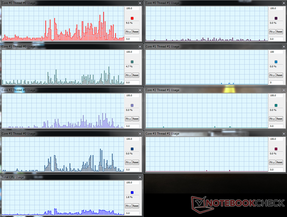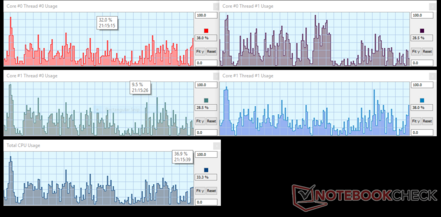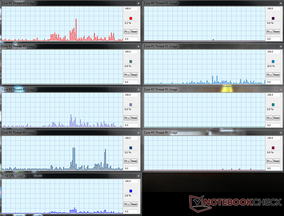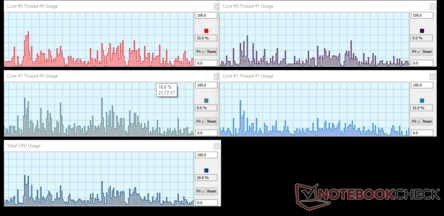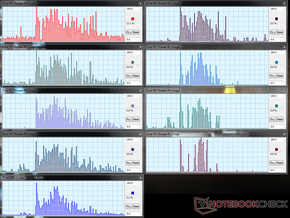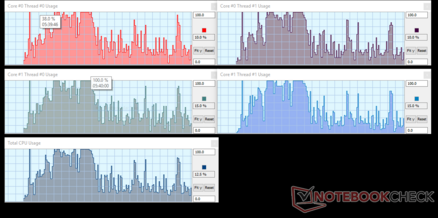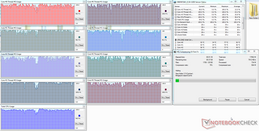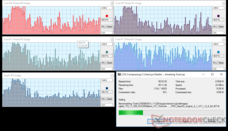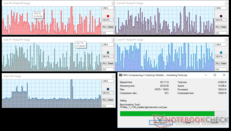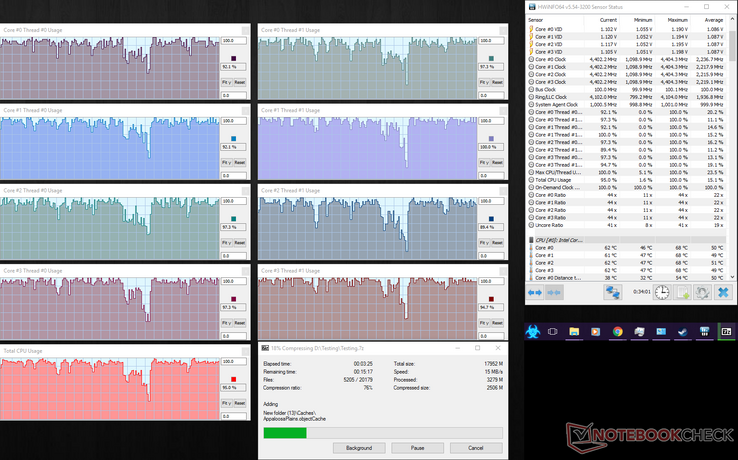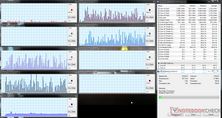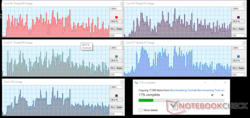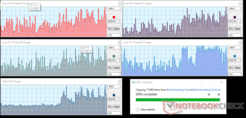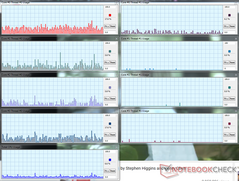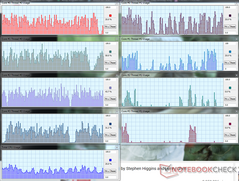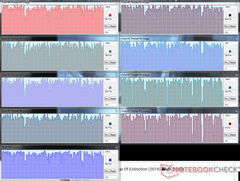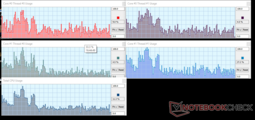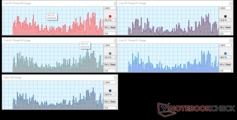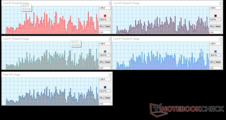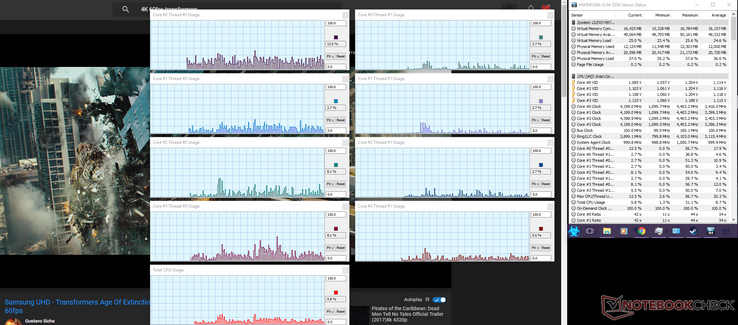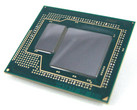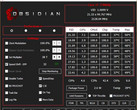Performance comparison: 15 W ULV dual-core vs. 45 W HQ quad-core CPU
With all our recent talk on throttling, some people might be thinking "So what? I don't need that much power anyway." Still, others will be furious that they aren't getting the processor cycles they paid for. This has brought our attention to the fact that many people buy laptops with only a vague understanding of what the HQ or U suffix means, and they often don't even know how much power they really need. Thus, an important question remains to be answered: what do we really need our CPU for in daily use? To what extent is it really utilized? Understanding the answers to these questions is the key to being a smart consumer as you will neither overpay for more power than necessary nor purchase a laptop that ends up being too underpowered.
To help answer this question, we have picked two systems (one with a 15-watt U-series CPU, another a 45-watt HQ-series CPU) to run through a battery of common tasks to see which tasks (if any) require full utilization of the CPU.
Methodology
To attempt to account for the variety of tasks conducted by the average user on a daily basis, we selected an assortment of 10 operations, both discrete (i.e. opening a file or launching a program) and continuous (i.e. watching a YouTube video).
CPU utilization for discrete tasks will be measured with HWiNFO64. Graphs showing utilization percentage for each CPU thread as well as total CPU utilization will allow approximate measurement of utilization, duration, and whether any spikes occurred. The graphs from HWiNFO64 cover a course of 2 minutes with the polling rate set to 5 updates per second. We measured CPU utilization percentage rather than clockspeed because of the way CPU utilization is calculated in HWiNFO64: percentage utilization is calculated relative to clockspeed, so to keep results consistent with each other, we pinned the clocks of our test unit's i7-6700HQ to 3.1 GHz. For most tasks, screenshots of the graphs were taken in such a manner that the resting CPU usage prior to beginning the task was still visible as well as the load usage. The list of tasks we selected are as follows:
- Large PDF opening using Adobe Reader (sample PDF file is Princeton's "Super large PDF" that is 100MB in size).
- Opening Google Chrome, set to restore last session, designed to emulate the kind of browser an average multi-tasker would use.
- Opening a massive Excel spreadsheet database (sample database file is a 10-step project assessment template).
- Large filesize compression using 7zip (tested data is multiple Sims 3 expansion pack install files; each expansion in its own folder & folder containing installers for multiple benchmark suites). This test is somewhat unique; more is explained about it below.
- Large filesize decompression using 7zip (tested data is the result of the above zipping test, extracted into its own folder).
- Watching a youtube video using google chrome at multiple resolutions with Hardware Acceleration enabled. For 720p and 4K, tested video is "Life in the garden (4K resolution) by Stephen Higgins and Henry Chen" and for 4K 60fps, tested video is "Samsung UHD - Transformers Age of Extinction (2014) 4K 2160p 60fps".
More details about the tests are provided below under each test's results section.
The test systems - Clevo N155RF (Sager NP7258), Toshiba Tecra X40-D
For this battery of tests, we decided to check both an Intel i7 ULV CPU (i7-7600U) as well as an Intel i7 HQ CPU (i7-6700HQ). With the impending release of Intel's Coffee 4-core/8-thread ULV and 6-core/12-thread H-series mobile CPUs we thought it would be an interesting experiment to see at which point (if any) a dual-core CPU is no longer sufficient for everyday tasks, since 4-core/8-thread and 6-core/12-thread CPUs will be the new standard for Intel's notebook chips very soon. Thus, we finally settled on the test systems described below: a Clevo N155RF (Sager NP7258) and a Toshiba Tecra X40-D.
Our Clevo test system contains an i7-6700HQ, GTX 965M (GM206 version), 8GB of 1600MHz RAM (single channel), with a Samsung 850 EVO 250GB M.2 drive and a HGST Travelstar 7K1000 1TB 7200RPM HDD for storage purposes. All tested programs will be installed on the SSD to reduce read/write bottlenecks. The Clevo's operating system is Windows 7 Ultimate x64
Our Toshiba test system contains an i7-7600U, 16GB of 2400MHz RAM (dual channel), with a Samsung PM961 256GB NVMe drive for storage purposes. Lacking a hard drive, all tested programs are installed on the SSD. The Tecra is running Windows 10 Pro.
Results
Note: For all the following graphs in this section, the X-axis covers two minutes, and each of the seven blocks on the Y-axis works out to 14.28% CPU utilization.
Large PDF opening and browsing
This test was fairly straightforward: The aforementioned 100 MB PDF file from Princeton's website was opened using Adobe Reader and then scrolled through using the mouse wheel. After an initial period of the base scroll-wheel action, the wheel was clicked and held while dragged, for a faster seek speed. Finally, we then rapidly dragging the scroll bar at the right from the top to near the bottom. No lag or issues were present while performing this action on either system, and with a maximum total CPU utilization of approximately 15% on the quad-core and 40% on the dual-core, most any computer made in the last few years should get through such a task with ease.
Large Spreadsheet opening and browsing
Once again, the spreadsheet test is fairly straightforward. The CPU hit is negligible on the quad-core and the dual-core still had plenty of breathing room. Similarly to the PDF test, any PC made in the last 5 years or so should have little issue with using spreadsheets (or even spreadsheets and PDFs together).
Opening Google Chrome
Google chrome was set up beforehand to restore the previous browser session upon opening, and the browser session was tailored to contain the following webpages: Gmail, Youtube's homepage, three youtube video tabs, three forums (one laptop forum, one health/bodybuilding forum, one car forum), Twitch.tv live followed broadcasters page, and facebook homepage. Many multitaskers use YouTube or websites like Spotify to play music in the background, and livestreaming websites are very popular today. Facebook, an e-mail client, and forums or discussion boards for a user's interests are somewhat standard for most people.
Opening multiple tabs at once spikes CPU usage quite heavily, but it does not last long. There is a heightened load after opening for a short period of time, but eventually the program settles to using rather minimal processing power in the background for the most part. After opening Google Chrome, all tabs were clicked through to ensure no delay in loading webpages was present. This period is included in the timeline in the above picture. It is worth noting that while both processors spike to about 100% at least for a little bit, the dual-core chip cleanly spikes higher overall and keeps a much higher load footprint for longer, indicating that while it may be an instantaneous benefit, the quad-core will simply handle such a task better.
We note that starting the browser does not usually hold 100% utilization very long if at all, but should one have multiple windows with multiple tabs open, closing one window and re-opening that window will force a processor cleanly to 100% — unlike restoring an entire browsing session. This is not pictured here, but it's interesting to note. Even with a powerful CPU, such an act will cause noticeable issues with any open program heavily dependent on the processor, such as a video game, where even on i7-7700Ks slowdowns to extremely low FPS ranges, garbled audio (ONLY from the game; rest of the system was fine), etc has been witnessed. The longer the CPU is pegged at max, the longer the program in question will suffer, of course.
Large filesize compression
Unfortunately, we could not get this same test running properly for both notebooks. For the Clevo, we took the installer data for multiple The Sims 3 expansions (each expansion in its own folder) and used 7zip to compress them all into one massive archive. The combined filesize of the folders was an impressive 17.3GB. As the test progressed, it was noted that unlike in other tests, the CPU killed its own boost clock down to 2.6 GHz. There were no reported limitations using Limit Reasons with Throttlestop, indicating that while the CPU was not boosting, it was not "throttling" either. As it turns out, this was tied to the "Balanced" power plan in Windows; despite the plan manually configured such that the speed be minimum 5% and maximum 100%, turbo boost was still revoked while it was active in this test (but not any prior tests). Copying every setting in the "Balanced" power plan into the "High performance" power plan (including 5% minimum and 100% maximum processor states) and then enabling the High Performance plan completely negated the loss of turbo boost for the processor.
While it sounds like a nonsensical problem (and fix), this is actually not a rare occurrence: it is present all the way up until Windows 10 and can even affect desktop processors. At some point, this issue can "go away" as if it never was present in the first place, but the "High Performance" power plan must be used for some time before it does. Waiting for this normalization was not attempted on the notebook in question, and so the results reflect the lower clocks. We recommend that if you are noticing your notebook losing turbo boost when performing certain heavier-load tasks, switching to (and editing to suit — especially if wishing to use the notebook on battery) the High Performance Windows power plan is recommended. For this reason, the picture taken was made while compressing (the compression easily lasted over half an hour) but after figuring out why turbo boost was not active, and therefore the graph did not capture the resting state prior to using the program. It is our opinion, however, that the resting state comparison was not needed due to the extremely high load on the processor.
On the Toshiba, however, we began using High Performance, so there was no issue with reduced clockspeeds during the testing. The test was not the same, however: we instead tested a folder full of multiple benchmark software installers (such as PCMark 7), and the results were surprisingly easy on the processor. What's more, performance seemed rather varied. Unlike on the Clevo unit which kept near maximum processor usage for the entire compression run (30 minutes or so), as the compression test continued on the Toshiba, it was clear that processor loads seemed to rise and fall depending on what was being compressed — meaning that the data from the Clevo unit is not indicative of all tests, but rather that each zip operation is unique depending on what is being compressed.
In light of the above revelation, one factor was failed to be examined: Windows 10 versus Windows 7. To test whether the above hypothesis is true — that the workload is what matters and that the operating system has little effect on compression performance, we used a second notebook to zip the same workload as the N155RF. This notebook is a Clevo P870DM3 running Windows 10. By comparison, this notebook has an overkill i7-7700K desktop processor in it, running at 4.4GHz, meaning a great excess of power is available compared to either test unit — but even so, this processor was also pegged almost entirely at 100% for the duration of the test, indicating that the OS neither boosts nor hinders compression in any meaningful way.
Large filesize decompression
Another fairly straightforward test. Unzipping data seems to be somewhat consistent in terms of CPU utilization regardless of what is being unzipped. The per-core utilization of the quad-core versus the dual-core indicates that almost regardless of what's being decompressed the load is approximately the same; at this point it is likely that RAM would have a larger impact. For the sake of being certain, unzipping was done from HDD to HDD, from HDD to SSD, and from SSD to SSD on the Clevo (the Toshiba does not have a HDD and can only do SSD to SSD). The extraction speed did not change, and neither did the average CPU load. The above picture for the Clevo unit is from HDD to HDD.
The Toshiba had high utilization at some points, but in general was able to handle the workload well. However, if decompression is what one wishes for, this may be in the realm where a quad-core CPU is going to help more.
YouTube video playback
Three YouTube video tests were conducted: playback of 720p 30fps, 4K 30fps, and 4K 60fps video. All tests were completed using Google Chrome with hardware acceleration enabled in the browser settings.
The 720p test was relatively easy to complete; most any CPU made in the last 6 years could comfortably get away with up to 1080p 60fps YouTube video watching based on this data, and the data for the 4K 30fps video suggests that it should be easily handled as well: while 4K 30fps was more difficult to complete, it should be simple enough for any quad-core CPU. There was a time in the past when watching 4K 30fps youtube on a high-end CPU would cause 100% utilization, but we are nearly a decade on from that era. This is a testament to how much faster CPUs have become (even through incremental updates).
Of interest to note — both here and with all prior tests — is that when CPU load is not sufficiently high, Windows tends to favor only one thread per CPU core and will use up to four cores easily until more load is required. On a dual-core CPU with hyperthreading (like the Toshiba's i7-7600U), all four threads are loaded much more easily.
The problem test is 4K 60fps. As hinted at in the 4K 30fps result, it appears that Windows 7 (and 8.1) cannot use GPU acceleration for videos in google chrome and other browsers (as is possible in Windows 10). An incomplete list of devices with VP9 decoding support can be found here (though not listed, the GTX 965M in the test unit is indeed GM206, and thus is capable, proving an OS-level limitation for VP9 decoding).
For this reason, the 4K 60fps video test, while not actually "maxing out" the processor utilization but instead hovering at very high usage, exhibited multiple stutters and freezes in the video and audio. The reason the CPU is not pegged consistently at 100% despite the load is because frame data is actually being dropped or discarded instead of being rendered, which causes the stutters. It is similar to livestreaming with very high compression — when the CPU cannot properly encode enough frames, it will spike close to 100% then drop utilization as it skips frames to encode as it cannot encode them on time.
Windows 7 and 8.1's lack of encoding support is important to mention, because while most users will be using windows 10 with newer machines, many work-based and enterprise laptops use Windows 7, even though Intel Kaby Lake and AMD Ryzen processors and onward are not "officially" supported on that operating system.
On the other hand, the Toshiba notebook has little issue completing any of these tests. The load from buffering is high on 4K 60fps, but not nearly enough to hinder the CPU or the playback functionality of the video. This is the largest advantage to the new operating system over the old ones, and is what Apple has been doing for years with OS X and Mac OS using their first party programs (like Safari). The CPU load is somewhat high considering rendering the video takes almost no processing power, but the dual-core still succeeds with little issue.
Since the Toshiba proved that once using Windows 10 the load on the processor is much reduced, it's now known that hardware acceleration works wonders when it is enabled. But what about gaming notebooks that use Gsync, which have their iGPUs disabled? Nvidia Pascal GPUs and some Maxwell GPUs are capable of hardware acceleration on Windows 10, so the Clevo P870DM3 from earlier was also used to test. It is to be noted that, while this notebook does have a far stronger CPU, the utilization percentage is what is important. In fact, the only added load on the system in this case is the one from the video buffering like with the Toshiba test. Buffering videos on YouTube adds CPU usage, and that is almost the entire extra load that is observed during the course of the video. This is what one can expect from all YouTube videos from any system that has hardware decoding enabled. It IS possible to turn hardware decoding off (and many users do, because it can cause bugs with video playback in many cases — especially on 60fps content), so both hardware acceleration on/off tests are useful to check.
Conclusion
The results for the tasks we chose are fairly straight-forward. They reveal that for many tasks, a relatively recent (1-4 generations old) 45W CPU does not even break a sweat. Something most users will notice most frequently on their computer would be the opening of Google Chrome (or other browsers) with a number of tabs auto-opening. However, opening Chrome only briefly spiked the CPU. By far the most taxing tasks was file compression (Zipping), but this too is dependent on what you are compressing. YouTube was very CPU-hungry at 4k 60 FPS, but it should be noted that from Intel's 7th generation (Kaby Lake), Nvidia's Pascal, and AMD's Polaris GPU lines onwards, hardware decoding is build into the GPU, so this should not be an issue moving forward (as long as one is willing to use Windows 10).
As the tests show, any 7th generation or later Intel CPU — ULV or not — should be able to handle most basic office or entertainment workloads just fine. If you will be doing heavier tasks, then you will almost certainly want a more powerful CPU (such as an i7-7700HQ or E3-1505M v6) in your laptop, and a solid unit with an i7-7820HK or a Clevo/MSI LGA model with an i7-7700K would be best reserved for laptops that need as much power as possible. Outside of that, while it's nearing a cliche at this point, the most important component to speed up their daily tasks will be a fast SSD for the vast majority of users.
As far as gaming goes, that is a subject of considerable depth that has many variables — keep your eyes out for our suite of benchmarks testing CPU utilization during gaming in the coming weeks!


 Deutsch
Deutsch English
English Español
Español Français
Français Italiano
Italiano Nederlands
Nederlands Polski
Polski Português
Português Русский
Русский Türkçe
Türkçe Svenska
Svenska Chinese
Chinese Magyar
Magyar

